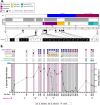Bacteriophage and antibiotic combination therapy for recurrent Enterococcus faecium bacteremia
- PMID: 38353560
- PMCID: PMC10936196
- DOI: 10.1128/mbio.03396-23
Bacteriophage and antibiotic combination therapy for recurrent Enterococcus faecium bacteremia
Abstract
Enterococcus faecium is a member of the human gastrointestinal (GI) microbiota but can also cause invasive infections, especially in immunocompromised hosts. Enterococci display intrinsic resistance to many antibiotics, and most clinical E. faecium isolates have acquired vancomycin resistance, leaving clinicians with a limited repertoire of effective antibiotics. As such, vancomycin-resistant E. faecium (VREfm) has become an increasingly difficult to treat nosocomial pathogen that is often associated with treatment failure and recurrent infections. We followed a patient with recurrent E. faecium bloodstream infections (BSIs) of increasing severity, which ultimately became unresponsive to antibiotic combination therapy over the course of 7 years. Whole-genome sequencing (WGS) showed that the patient was colonized with closely related E. faecium strains for at least 2 years and that invasive isolates likely emerged from a large E. faecium population in the patient's gastrointestinal (GI) tract. The addition of bacteriophage (phage) therapy to the patient's antimicrobial regimen was associated with several months of clinical improvement and reduced intestinal burden of VRE and E. faecium. In vitro analysis showed that antibiotic and phage combination therapy improved bacterial growth suppression compared to therapy with either alone. Eventual E. faecium BSI recurrence was not associated with the development of antibiotic or phage resistance in post-treatment isolates. However, an anti-phage-neutralizing antibody response occurred that coincided with an increased relative abundance of VRE in the GI tract, both of which may have contributed to clinical failure. Taken together, these findings highlight the potential utility and limitations of phage therapy to treat antibiotic-resistant enterococcal infections.
Importance: Phage therapy is an emerging therapeutic approach for treating bacterial infections that do not respond to traditional antibiotics. The addition of phage therapy to systemic antibiotics to treat a patient with recurrent E. faecium infections that were non-responsive to antibiotics alone resulted in fewer hospitalizations and improved the patient's quality of life. Combination phage and antibiotic therapy reduced E. faecium and VRE abundance in the patient's stool. Eventually, an anti-phage antibody response emerged that was able to neutralize phage activity, which may have limited clinical efficacy. This study demonstrates the potential of phages as an additional option in the antimicrobial toolbox for treating invasive enterococcal infections and highlights the need for further investigation to ensure phage therapy can be deployed for maximum clinical benefit.
Keywords: bacteriophage therapy; phage-neutralizing antibodies; vancomycin-resistant Enterococcus faecium.
Conflict of interest statement
G.H. is a recipient of research grants from Allovir, Karius, and AstraZeneca. G.H. also serves on the scientific advisory boards of Karius and AstraZeneca and has received honoraria from MDOutlook.
Figures


Similar articles
-
The importance of adjusting for enterococcus species when assessing the burden of vancomycin resistance: a cohort study including over 1000 cases of enterococcal bloodstream infections.Antimicrob Resist Infect Control. 2018 Nov 14;7:133. doi: 10.1186/s13756-018-0419-9. eCollection 2018. Antimicrob Resist Infect Control. 2018. PMID: 30459945 Free PMC article.
-
Phage-Antibiotic Cocktail Rescues Daptomycin and Phage Susceptibility against Daptomycin-Nonsusceptible Enterococcus faecium in a Simulated Endocardial Vegetation Ex Vivo Model.Microbiol Spectr. 2023 Aug 17;11(4):e0034023. doi: 10.1128/spectrum.00340-23. Epub 2023 Jun 20. Microbiol Spectr. 2023. PMID: 37338375 Free PMC article.
-
Genome-Based Analysis of Enterococcus faecium Bacteremia Associated with Recurrent and Mixed-Strain Infection.J Clin Microbiol. 2018 Feb 22;56(3):e01520-17. doi: 10.1128/JCM.01520-17. Print 2018 Mar. J Clin Microbiol. 2018. PMID: 29263205 Free PMC article.
-
Treatment options for vancomycin-resistant enterococcal infections.Drugs. 2002;62(3):425-41. doi: 10.2165/00003495-200262030-00002. Drugs. 2002. PMID: 11827558 Review.
-
A molecular study regarding the spread of vanA vancomycin-resistant Enterococcus faecium in a tertiary hospital in China.J Glob Antimicrob Resist. 2022 Dec;31:270-278. doi: 10.1016/j.jgar.2022.10.010. Epub 2022 Oct 20. J Glob Antimicrob Resist. 2022. PMID: 36273808 Review.
Cited by
-
From Isolation to Application: Utilising Phage-Antibiotic Synergy in Murine Bacteremia Model to Combat Multidrug-Resistant Enterococcus faecalis.Microb Biotechnol. 2025 Jan;18(1):e70075. doi: 10.1111/1751-7915.70075. Microb Biotechnol. 2025. PMID: 39801028 Free PMC article.
-
Enterococcus faecium sagA mutants have cell envelope defects influencing antibiotic resistance and bacteriophage susceptibility.bioRxiv [Preprint]. 2025 Jul 21:2025.07.21.665895. doi: 10.1101/2025.07.21.665895. bioRxiv. 2025. PMID: 40777461 Free PMC article. Preprint.
-
Bacteriophage Therapy as a Promising Alternative for Antibiotic-Resistant Enterococcus faecium: Advances and Challenges.Antibiotics (Basel). 2024 Nov 23;13(12):1120. doi: 10.3390/antibiotics13121120. Antibiotics (Basel). 2024. PMID: 39766510 Free PMC article. Review.
-
Prophylactic phage administration provides a time window for delayed treatment of vancomycin-resistant Enterococcus faecalis in a murine bacteremia model.Front Microbiol. 2025 Jan 24;15:1504696. doi: 10.3389/fmicb.2024.1504696. eCollection 2024. Front Microbiol. 2025. PMID: 39925887 Free PMC article.
-
Current Clinical Laboratory Challenges to Widespread Adoption of Phage Therapy in the United States.Antibiotics (Basel). 2025 May 29;14(6):553. doi: 10.3390/antibiotics14060553. Antibiotics (Basel). 2025. PMID: 40558145 Free PMC article. Review.
References
-
- Centre for Disease Control . 2019. Antibiotic resistance threats in the United States, 2019. U.S. Department of Health and Human Services, CDC.
-
- Haidar G, Chan BK, Cho S-T, Hughes Kramer K, Nordstrom HR, Wallace NR, Stellfox ME, Holland M, Kline EG, Kozar JM, Kilaru SD, Pilewski JM, LiPuma JJ, Cooper VS, Shields RK, Van Tyne D. 2023. Phage therapy in a lung transplant recipient with cystic fibrosis infected with multidrug-resistant burkholderia multivorans. Transpl Infect Dis 25:e14041. doi:10.1111/tid.14041 - DOI - PMC - PubMed
-
- Paul K, Merabishvili M, Hazan R, Christner M, Herden U, Gelman D, Khalifa L, Yerushalmy O, Coppenhagen-Glazer S, Harbauer T, Schulz-Jürgensen S, Rohde H, Fischer L, Aslam S, Rohde C, Nir-Paz R, Pirnay J-P, Singer D, Muntau AC. 2021. Bacteriophage rescue therapy of a vancomycin-resistant Enterococcus faecium infection in a one-year-old child following a third liver transplantation. Viruses 13:1785. doi:10.3390/v13091785 - DOI - PMC - PubMed
MeSH terms
Substances
Grants and funding
LinkOut - more resources
Full Text Sources
Research Materials

